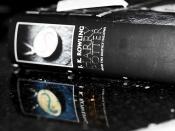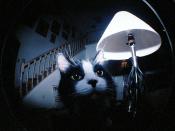As is typical to the genre of Film Noir, Carol Reed's The Third Man is a film of suspense and intrigue, full of shadows and twisting plots. The film's antagonist, Harry Lime, remains unseen during the first two thirds of The Third Man, however, his presence is felt throughout the entire time he is absent. This is achieved due to the use of cantered camera angles, harsh three-point lighting and a striking non-diegetic aural accompaniment. Lime's absence is first noted by protagonist Holly Martins as he enters Vienna, when he claims "I thought he would be here to meet me."
The zither which was heard in the background of the introduction suddenly increases volume, and the song played is subtly referring to Lime's. This notion is also seen a little later after Martins' first conversation with the Porter. After this scene the music begins again, and only dies down for Calloway to inform Martins that the person dead is "a fellow called Lime."
The zither jolts again, showing that this music is directly linked to Lime or his actions that directly influence the progression of the plot. The zither is also heard when Anna Schmidt and Martins speak with the Porter inside Lime's apartment. This time the music is softer, and more morose, showing Anna's feelings for missing Lime. This shows her longing for him, and also reveals more about her character, and displays Lime's presence, through learning more information about his death. His presence is also seen, though we don't know it yet, on the bridge in Vienna. Popesco appears on the phone after his meeting with Martins at the Casanova club and the Baron, Winkle and he arrange to "meet at the bridge." The zither is playing in the background again. This shows that Harry is...


